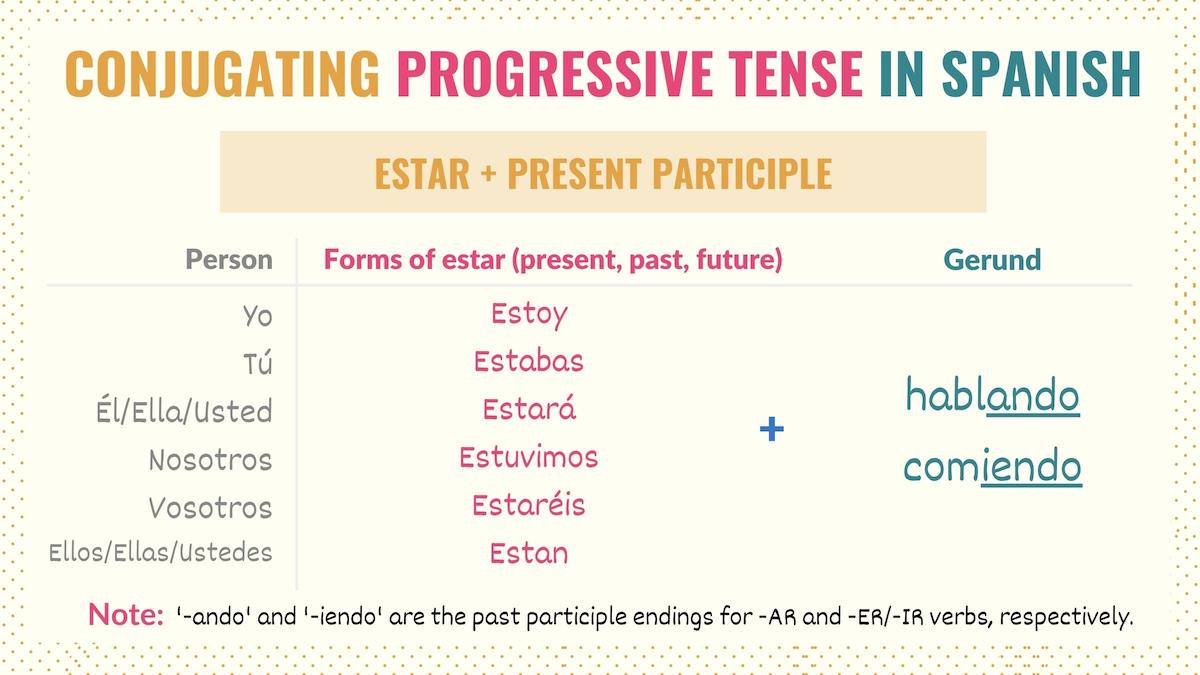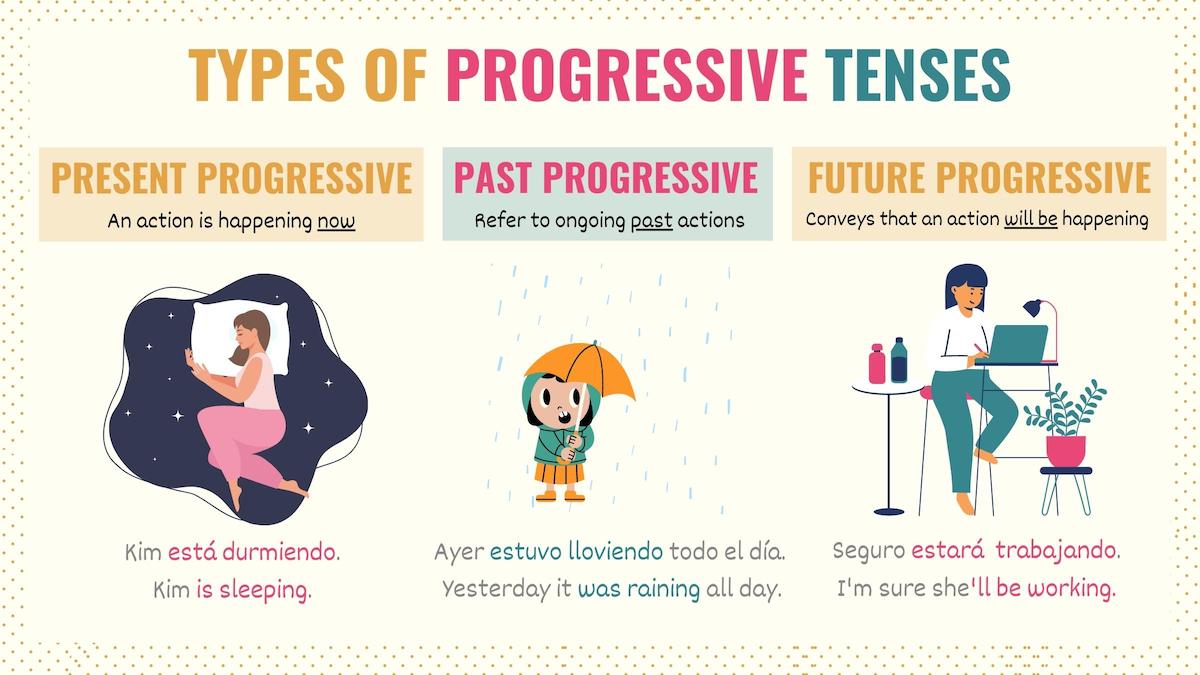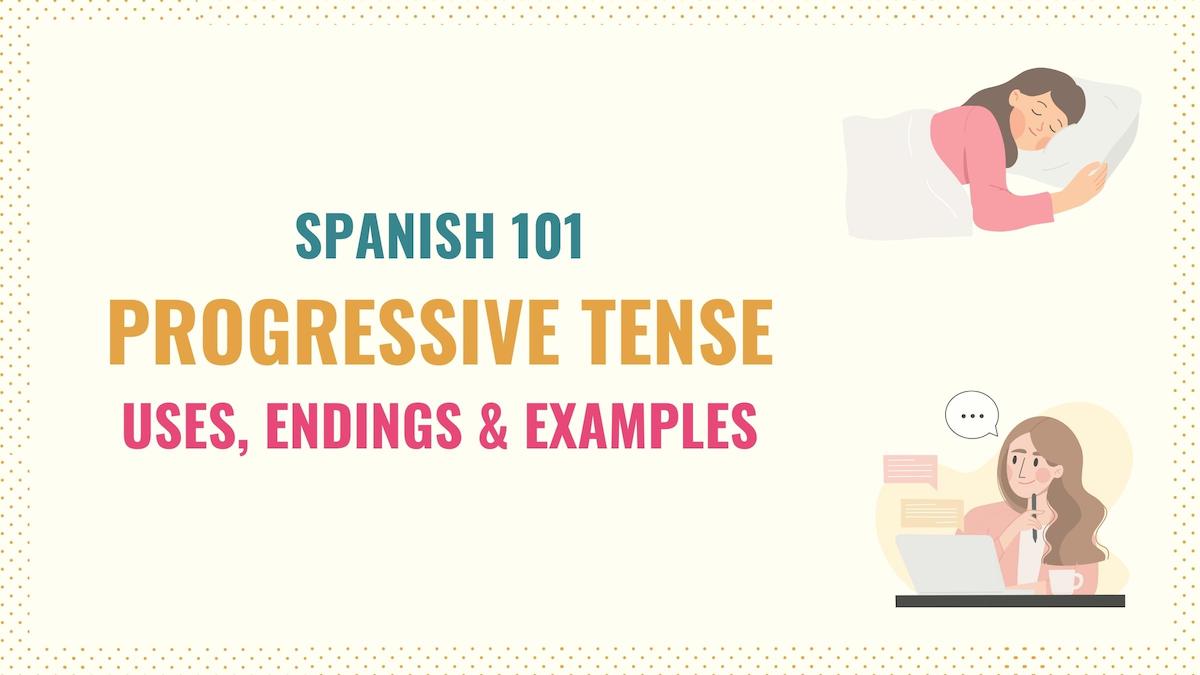Progressive forms are often used in daily conversations to emphasize ongoing actions at different times. In short, these Spanish tenses are crucial to conveying your ideas correctly. As a result, in this Spanish progressive tense guide, you’ll find key information to master these forms.
Here is an overview of what you’ll learn:
- How to Form Progressive Tenses in Spanish
- When & How to Use Progressive Verb Forms
- Key Points
- Additional Resources For Verb Conjugation
Let’s get started!
Progressive Form Spanish Conjugation
A progressive tense in Spanish is formed by combining the verb estar + present participle.
With this formula, estar is a Spanish auxiliary verb. In other words, it must be conjugated to express who performs the action and when such events take place. For the progressive forms, the auxiliary is only conjugated in the present, past, or future tense.
By contrast, the present participle, also called gerund, is the main verb. Simply put, it conveys what happens (the action). Regular Spanish gerunds end with –ando or -iendo, the equivalent of -ing verbs in English.
Here is a Spanish progressive tense conjugation chart for the verbs hablar and hacer:
| -AR Verbs | -ER / -IR Verbs | |
|---|---|---|
| Present progressive | Estoy hablando | Estoy haciendo |
| Past progressive | Estuve hablando Estaba hablando | Estuve haciendo Estaba haciendo |
| Future progressive | Estaré hablando | Estaré haciendo |
The table above only contains the conjugation for the first-person pronoun (yo).
When using a progressive tense in Spanish, the estar forms must match the subject of the sentence:
Lara está hablando con Mike.
Laura is talking to Mike.
Niños, ¿qué estaban haciendo?
Kids, what were you doing?
Estamos haciendo unas galletas.
We are making some cookies.
Here is a graphic that can help you remember how to form the progressive tenses in Spanish:

Take Note: In Spanish, the progressive tenses are often formed with estar. However, you can also use the verbs seguir, andar, llevar, ir, and venir to refer to ongoing actions. Keep in mind that these words will add a specific nuance to your sentence.
When & How to Use the Progressive Tenses in Spanish
The Spanish progressive tenses refer to ongoing actions at different moments in time. Simply put, these tenses indicate that an action is, was or will be in progress.
Because the nuances can vary depending on the tense you use, below, you’ll find a more detailed description for each progressive form.
Tip: Progressive forms can also be called continuous tenses.

Spanish present progressive
The present progressive in Spanish emphasizes that an action is happening at the moment of speaking or to express long-term activities that are still in progress. Here are some sentences:
[Present forms of estar] + [gerund]
¿Qué estás viendo?
What are you watching?
Mindy está preparando la cena.
Mindy is preparing dinner.
Los niños están aprendiendo a hablar.
The kids are learning to talk.
El perro está durmiendo.
The dog is sleeping.
Unlike English, in Spanish, this form is never used to talk about future plans or arrangements. In such cases, you’ll have to use the present indicative or the near future tense:
Incorrect
Se están yendo mañana.
They’re leaving tomorrow.
Correct
Se van mañana.
They’re leaving tomorrow.
In English, the present progressive tense is used much more frequently when talking about current actions. In Spanish, the present tense is more common in these cases. Knowing when to use the present progressive tense over the present tense takes learning its uses and practice.
Sometimes either tense is acceptable. Check the examples below:
Present progressive
Él siempre se está quejando.
He is always complaining.
Present tense
Él siempre se queja.
He always complains.
In English, the present progressive version of this statement is the one we would use to talk about what the subject (he) is doing at the present moment (se está quejando). In Spanish, however, it’s very common to hear the present tense version (complaints).
While either tense is acceptable in many situations, there are many instances when we cannot use the present tense over the present progressive. Click here to learn the rules of the present progressive tense and when to use it.
Past progressive Spanish tense – Preterite & Imperfect
In Spanish, the past progressive is used to:
- Express that an action was occurring for a period of time (it was ongoing).
- Express that a past action in-progress was interrupted by another event.
- Talk about simultaneous past actions.
Here are some examples:
Use #1: Actions that were happening for a period of time
Ayer estuvo lloviendo todo el día.
Yesterday it was raining all day.
¿Por qué estabas llorando?
Why were you crying?
Use #2: Past, in-progress actions that were interrupted
Harry estaba leyendo cuando le hablé.
Harry was reading when I called him.
Todavía estaba trabajando cuando me fui.
She was still working when I left.
Use #3: Past actions occurring simultaneously
Ellos estaban vistiéndose mientras yo cocinaba.
They were getting dressed while I cooked.
Mientras tú dormías, yo estaba limpiando la cocina.
While you were sleeping, I was cleaning the kitchen.
Because it doesn’t refer to finished actions, this tense is used to provide background information about the past. The past progressive in Spanish is more often formed with the imperfect forms of estar. However, the preterite forms can be used with specific dates and past reference points.
Future progressive
In Spanish, the future continuous is less common than the other progressive forms. We use it to refer to an action that will be happening at some point in the future. This tense can communicate certainty or can be used to make assumptions about what someone will be doing.
Here are some examples:
Seguro estarás viendo televisión.
I’m sure you’ll be watching TV.
Si necesitas algo, estaré preparando la cena.
If you need something, I will be preparing dinner.
En unos días, estaremos celebrando nuestro aniversario.
We will be celebrating our anniversary in a few days.
Conditional Progressive
Finally, we get to the conditional progressive tense. The good news is that this tense is not as common as the other three. So, there’s no rush to learn it. Like in English, the conditional progressive refers to actions you would be doing if a condition was met.
Here are some examples of this tense:
Si pudiera, ahorita estaría viajando con mis amigos.
I could, right now I would be traveling with my friends.
Estarían pagando la renta si tuvieran dinero.
They would be paying the rent if they had money.
When expressing conditional ideas, we often use the conditional simple tense instead of its progressive form.
Key Points
- Progressive tenses in Spanish are used to talk about actions that are occurring over time.
- Progressive tenses are composed of two verbs:
- The auxiliary Spanish verb (usually estar) conjugated to the Present, Past (preterite or imperfect), or Future.
- A verb describing the primary action that someone or something is doing in gerund (present participle) form.
- Estar (or other auxiliary verb) is conjugated to indicate who (the subject) and when the action is, was or will be happening.
- The verb in gerund form expresses the primary action.
- Gerund verbs are verbs which end with -ing in English. Their conjugation is fixed (does not change).
- The present progressive is most often used, followed by past and future progressive.
- The conditional progressive is not as common.
Spanish Progressive Tense Additional Resources
Because they help you focus on ongoing actions, the progressive forms in Spanish are essential. There are a few things you can do to master them.
For starters, get familiar with the basic conjugations of estar since they’re a crucial part of these tenses. Because the primary action is always in the verb’s gerund form, you must also understand how to form present participles. When checking these verb forms, make sure you take the time to learn where to place object pronouns correctly.
Spanish tenses help you place the time of an action (when something happens). So, to become fluent in this language, you should know how to use its most common tenses.
Download the Spanish Progressive Tenses PDF
Learning a new Spanish tense can be one of the more challenging parts of grammar for beginners. However, this guide contains numerous new tenses to learn. I’ve created a free PDF you can download with all the graphics, key points and examples for each tense – present progressive, past, and future. Feel free to download a copy to review and study when you need it!



